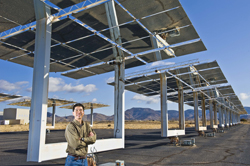ALBUQUERQUE, N.M. – Sandia National Laboratories’ Clifford Ho has been selected by the Chinese Institute of Engineers ─ USA to receive the Asian American Engineer of the Year Award. The honor is presented each year to the nation’s most outstanding Asian American engineers and scientists who make significant, lasting and global contributions to the nation. Ho will be recognized for his achievements on February 27 at a ceremony in New Brunswick, New Jersey.
“I am elated, happy and honored,” Ho said. “It’s a great feeling to receive this award, and I’m looking forward to the ceremony later this month.” Ho was nominated for his extensive and diverse work during his nearly 17-year career at Sandia. He joined the Labs in 1993 to develop thermal-hydrologic models for the Yucca Mountain Project. Soon afterward he became a lead investigator on the Viability Assessment and Site Recommendation for Congress and the president. During that time, he also led the development of comprehensive performance-assessment models of complex systems ranging from long-term covers for waste isolation to chemical transport through skin.
In 2000, Ho initiated and led a project to develop microchemical sensors to monitor environmental contaminants in wells, which led to four patents and significant commercial industry interest. Starting in 2005, he led research in water treatment and distribution security, including UV disinfection and modeling to predict how contaminants would move through the water distribution network. Ho worked closely with the American Water Works Association Research Foundation, now known as the Water Research Foundation, and several industry partners.
In 2008, Ho turned his attention to solar energy and is currently principal investigator in a group that investigates ways to capture and store solar energy for utility-scale electricity production using concentrating solar power. Concentrating solar power uses a large array of mirrors to focus sunlight onto a receiver, harnessing the resulting heat to generate electricity using a heat engine. Ho works closely with the Department of Energy and industry to improve the performance and lower the costs of these systems. For example, the force of gravity and wind can distort the shape of the mirrors, decreasing efficiency and ultimately increasing the cost of electricity. Ho models those changes to predict and understand impacts of wind and gravity, and then uses that data to help design more efficient systems with fewer losses.
In addition, Ho is interested in developing innovative energy forecasts, which tie national weather forecasts to intermittent renewable energy supplies from sources such as solar and wind. By looking at which areas of the country will generate electricity with renewable sources, engineers can determine how to distribute power on a nationwide smart grid several days in advance, thus reducing the need for fossil-fuel-based energy sources such as coal powered plants.
“The objective is to balance the predicted loads with the energy availability from renewable energy sources throughout the country,” Ho said. “The results can be used to better prepare the smart grid for possible energy shortages or excesses in various locations. The idea is that engineers could run models to simulate and predict how renewable energy sources change throughout the day, and use that information to transfer surplus electricity to areas that need it.”
Ho also created an award-winning video that explains how solar energy can supply our three primary energy needs: Heating, On-site electricity production, and Transportation. His video, “Solar Energy is H.O.T.” took first place in Discover Magazine’s Future of Energy in 2-Minutes-or-Less Video Contest (http://discovermagazine.com/contests/vote-for-the-future-of-energy-in-2-minutes-or-less/).
Key reasons for Ho’s nomination were his innovative work and creative approaches to engineering challenges. “As witnessed by his list of publications and the broad support he received from the research community for his nomination, Cliff Ho is an outstanding engineer and analyst,” said Tom Mancini, Concentrating Solar Power Manger. “What isn’t immediately apparent in his vitae is that Cliff is an excellent communicator; he is very good at placing boundaries around problems and stating them in such a way as to make them more readily understood.”
Ray Finley and Laurence Costin, who have been Ho’s managers at Sandia and have known him since the beginning of his career, wrote in their letter of support, “Cliff is an outstanding scientist and engineer who, over many years, has demonstrated a significant impact on the betterment of society in the true spirit of the engineering profession.”
Past recipients of this prestigious award include U.S. Secretary of Energy and 1997 Nobel Prize winner in Physics Steven Chu, former chancellor of the University of California at Berkeley Dr. Chang-Lin Tien, former Senior VP of Intel Dr. Albert Y.C. Yu and five other Nobel laureates in Physics and Chemistry.
Ho’s life outside of work also reflects his commitment to excellence and dedication to family, community and education. His parents moved from China in the 1950s, and Ho was born and raised in Wisconsin. He attended the University of Wisconsin – Madison, where he earned his Bachelor’s degree in Mechanical Engineering before moving to the University of California – Berkeley. There, he completed his Master’s degree and Doctorate in Mechanical Engineering. After graduation, he and his wife, Sylvia, both accepted jobs at Sandia.
“Receiving this award is a great honor, and I am so pleased to represent Sandia,” Ho said. “I think one of the best things about working here is the diversity and the opportunities that Sandia provides for its engineers. The ability to work on many different yet nationally important programs within the same company is very rare and I genuinely appreciate that. It’s been wonderful.”

